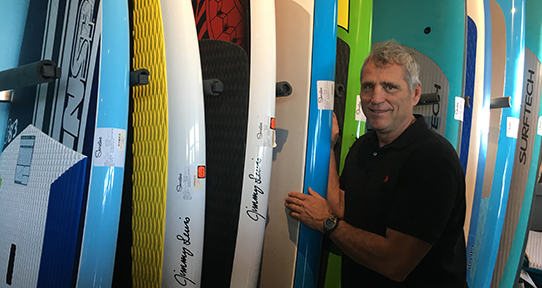Gerald Hartwig

Taking concussion too lightly
“The wonderful thing about brain damage is that the person with it has no concept there’s anything wrong.” Victoria businessman Gerald Hartwig says wryly.
His most recent injury took place in Mexico while he was kite-boarding. Gerald was ten feet above the ocean performing a back roll when he looped his kite early, sending him plummeting down to the water at 30 miles an hour. Despite the helmet, his head took the full impact of the fall. Gerald had just received his twelfth concussion. When Gerald got back up on his board, he saw kite-boarders around him gradually becoming smaller, until they were pinpricks on the horizon. He wondered why they didn’t come closer to shore, for safety. Eventually, he realized it was he who had drifted far out to sea. In the fog of his brain trauma, reality had become distorted. Luckily, he was able to get back to dry land safely.
Life in disarray
He remained active—kite-boarding and surfing—for the rest of that vacation, but those who knew him were concerned about his strange behaviour and lack of coordination. Over the next few weeks Gerald’s symptoms worsened, affecting his health, business and personal relationships. “It’s as if a filing cabinet got kicked over, and the files are all over the floor, and the wind is blowing and you’re trying to stuff all the papers back in files and into the drawers,” he explains. “That’s what it’s like, inside your brain, when you have all these protons and neurons running around trying to sort themselves out.” Finally, an athletic therapist persuaded Gerald to seek help at the Concussion Lab at the University of Victoria run by Dr. Brian Christie. Gerald’s long-time friend, Kim Oslund, was a PhD candidate at the lab.
Tracking progress at UVic’s Concussion Lab
At his first appointment Kim asked Gerald to stand on one leg. He couldn’t. She asked him to remember four words in sequence. He couldn’t. Then she introduced the Neurotracker cognitive training software to Gerald, asking him to follow moving balls on the screen. Even though the balls were barely moving, his score was 0.18. Through his muddled cognition, Gerald remembers Kim crying. It was the lowest score Kim had recorded during her research to that date. Together, Kim and Gerald developed an intensive rehabilitation program using technology in the lab, physical therapy, yoga and meditation. Gerald visited the lab three times a week over the next eight months and gradually his score increased to a respectable 1.78.
Awareness and research
Gerald gained so much through his involvement, he wanted to repay the lab by contributing funds towards research. He’s also become a passionate advocate for concussion research and awareness, especially in children. “I think the work they are doing in the Christie lab is vitally important. There’s a real need for more understanding in the community,” Gerald says, and after a slight pause, sums the issue up, “People take this invisible illness way too lightly.”
